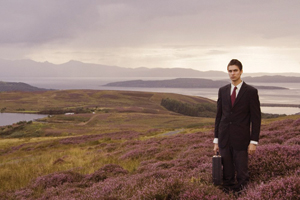Wendy Law asks if it is time to reappraise the relationship between public funding and the business context for the visual arts.

In recent years, there has been a growth of professional development training for visual artists, through agencies such as the Cultural Enterprise Office in Scotland, and a-n and Artquest in England. While some art colleges may still view professional development as an interloper in the core mission of artistic creative development, others, such as Edinburgh College of Art, embrace such programmes to prepare artists for the opportunities and challenges ahead. Yet there is a distinct lack of opportunity for our ‘professionally developed’ artists to operate within the context of business. Can this be attributed, in part, to the sector’s ambivalent attitude to commerce? The public perception of the visual arts is a sector that prides itself on operating differently to other creative disciplines. With national cultural policy now so focused on the creative industries, this distance is becoming ever more apparent.
The impression that the serious (i.e. critically engaged) visual arts is more public sector than business sector may be exacerbated by an often- held view that for great art to be created artists need to remain unsullied by and detached from commerce. We know that contemporary art is big business – albeit only for the few. At a time when the cultural, technological and economic tectonic plates are shifting, many opportunities are presented for the visual arts sector to add to its strengths, and explore new business models and research new revenue streams.
LESSONS FROM DOWN UNDER
Some of these opportunities are identified by the Australia Council in its Arts Content for the Digital Era strategy (2008), which “seeks to encourage the sector to test new copyright and business models and be open to licensing content for reuse where appropriate. It will also be important for the sector to pursue opportunities to commercialise their intellectual property and approach their business practice with the same innovation as they do their arts practice,” while recognising that support may be required.
The principle of art for art’s sake is an important one, as is the principle of continued public funding to support the visual arts. However, we need to embrace new scenarios where ideas and intellectual property, research, image content or the physical work itself, are recognised for their intrinsic artistic worth and for their ability to generate income in a business context.
MUSIC INDUSTRY LESSONS
The music industry offers an interesting model. The online music provider Spotify is a model where access replaces ownership, where rethinking distribution models and making something free leads to greater public engagement. This can lead to income generation as people pay to access special content. Spotify has brokered relationships with the owners of music labels and secured licenses from aggregates such as music societies, resulting in benefits to artists, societies and consumers. There are several such aggregates within the visual arts. With investment, there is scope to market digital image resource beyond the usual educational or artist referral remit, and to start to broker permissions and business to benefit artists. There is, quite rightly, an emphasis on protecting artist copyright and intellectual property, but much more can be done to promote artists’ ideas, skills and research. The Internet has changed views, behaviours and expectations. There is a move away from the monopoly of the ‘hits’ culture, and beyond the mainstream, to niche markets where a collective intelligence endorses and supports the alternative and innovative. The ready access ethos of the Internet may seem at odds with a sector where authenticity and scarcity underpin intrinsic value and worth. We see, however, from online music industry models, that people seek out the authentic physical experience. The relationship between public funding and non-profit organisations and the commercial sector can be a close and beneficial one.
LOOKING AHEAD
Arts Council England has recently commissioned recoupment guidelines to encourage visual arts organisations to recoup their production costs (as in the film industry), and protect public investment in art commissions or exhibitions in the event of sales; and in 2009 the Own Art Scheme celebrated over £10.5m arts and crafts sales bought through its interest-free loans, £6.5m of which went to artists. The Design and Artists Copyright Society, through the Artist Resale Right (Droit de Suite), has collected over £10.3m in resale royalties for over 1,700 artists since 2006. The visual arts is not a sector that needs to prove itself in economic terms: it is a huge global economy. However, it is a sector in which the spotlight of critical validation and financial reward presently shines on too small a proportion of the UK’s artistic talent. It is time to extend that beam, and to embrace new models. For the visual arts to be perceived to be set apart in such times of political, social and economic development risks leaving it in a cultural slipstream. An early warning sign might be taken from Creative Scotland’s choice of new Advisory Groups for music, film, performance, digital design, fashion, textile and crafts. At the time of writing, the visual arts are still nowhere to be seen.
WENDY LAW is a visual arts consultant, and is based part- time at the School of Arts & Creative Industries, Edinburgh Napier University. She worked for 12 years in the visual arts at the Scottish Arts Council.
w http://www.wendylawart.com
This week Wendy met with Jerwood sculpture prize winner Michael Visocchi and A&J Burridge Architects. She visited ‘Drawing for instruction: The art of explanation’ at the Talbot Rice Gallery in Edinburgh, watched ‘The Virtual Revolution’ and read ‘Seven Days in The Art World’ by Sarah Thornton.



